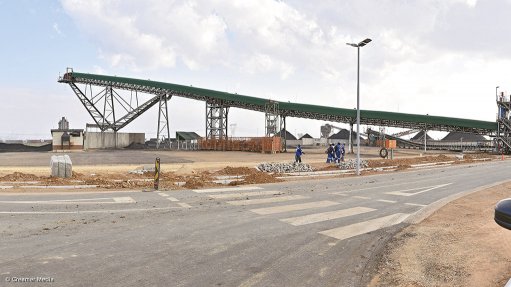
The Mpumalanga-based mine should produce 2.7-million tonnes a year of coal for export over a 17-year life-of-mine
Photo by: Dylan Slater
The R3.3-billion Belfast implementation project, owned by JSE-listed resources group Exxaro Resources, will result in the first mine in South Africa with a digital twin.
“The twin is a digital replica of the mine,” said Exxaro business unit manager Lazarus Ramashibela at a mine site visit in October, where he noted the need to use data to extract value from the operation.
The digital twin enables management and employees to connect to and manage the mine remotely from any location. Maintenance teams and operators can also connect to specific equipment to analyse and manage productivity, resulting in increased safety and reduced downtime.
The digital and connected mine also includes an integrated operations hub to constantly provide complete visibility of operational performance and the flow of material across the value chain. Subsequently, technical specialists and subject experts can view near real-time data and make recommendations and decisions remotely and without delay.
Construction of the Belfast mine, in Mpumalanga, started in November 2017, with mining taking place simultaneously, enabling Belfast to generate revenue during the process.
The digital twin was employed during the construction of Belfast to create a three- dimensional (3D) model. When combined with drone imagery, the model allowed for the design to be checked against the progress on site and to update the digital twin as construction progressed, Ramashibela explained.
“In the construction phase, we moved from 3D to 4D [modelling] for project performance and simulation analysis.”
Now in the commissioning phase, Belfast is using 5D modelling, comprising real-time estimations or predictions of modelling and optimisation scenarios for value engineering.
Further, 6D modelling will be employed to track and manage sustainable elements on site and for the analysis thereof, while 7D modelling will be used to manage maintenance and optimise yield.
The first-of-its-kind digital mine produced thermal coal six months earlier than expected on September 13, and should produce 2.7-million tonnes of coal a year for export over a 17-year life-of-mine.
Through digitalisation, Exxaro expects a 20% improvement in Belfast’s yearly production over the first five years, translating into more than R1-billion of additional revenue over the same period.
The Belfast mine, 55 km east of Middelburg, is on track to “power up” ahead of schedule in 2020, contributing R39-billion to the economy, and is expected to reduce local unemployment by as much as 2%.
At a traditional mine, it could take a year to ramp up, but ramp-up at Belfast should take three months owing to digitalisation, said Ramashibela.
As of October 30, just under R2.9-billion had been spent on the development of Belfast, which was being built with the intention to “revolutionise and change the face of mining”, he noted.
However, Ramashibela emphasised: “In the current state of the economy, it is not clear if another mine like this will be developed”.